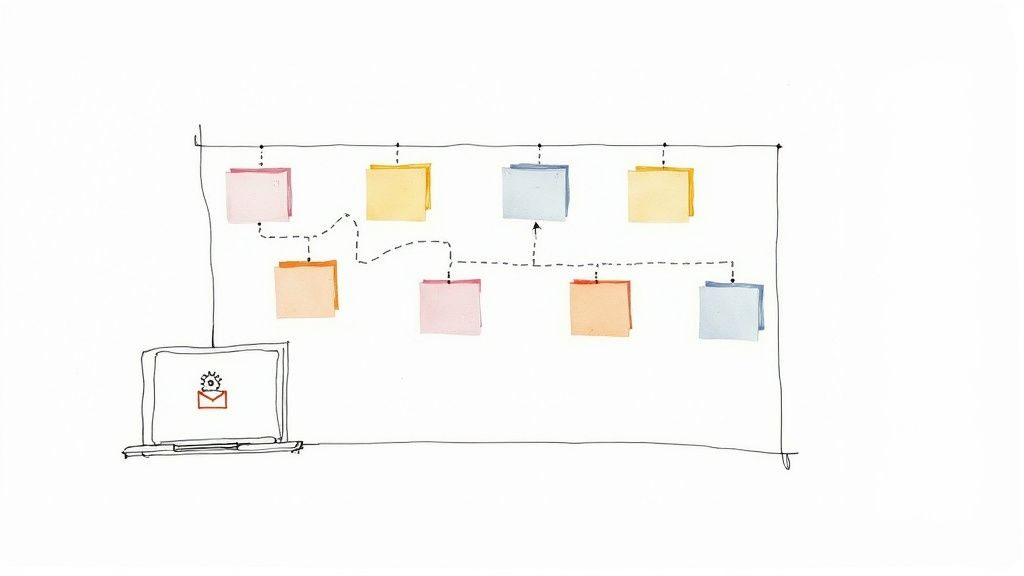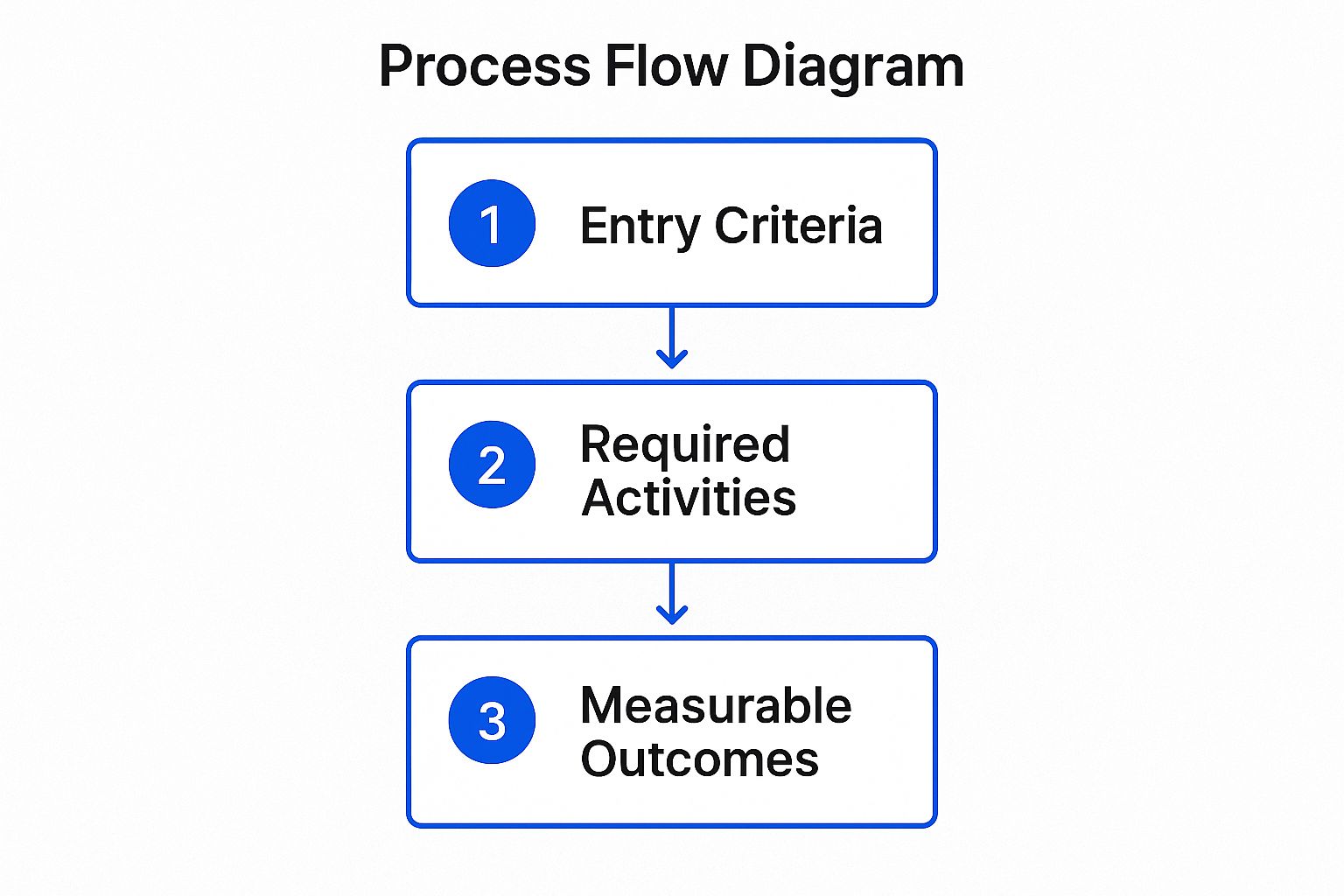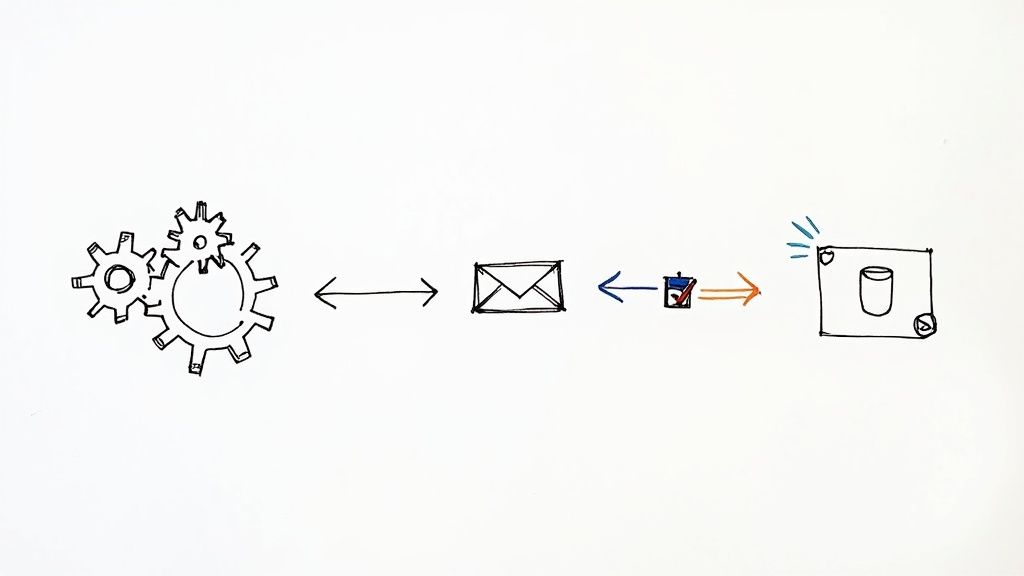
7 Actionable Sales Pipeline Management Tips for 2025
Discover 7 expert sales pipeline management tips to streamline your process. Optimize your workflow in Google Workspace and boost revenue in 2025.

In today's competitive landscape, a disorganized sales pipeline is a direct path to missed opportunities and stalled growth. Many teams struggle with manual tracking, data silos, and a lack of visibility, often juggling multiple tools that create more friction than flow. The key to predictable revenue isn't just working harder; it's working smarter by optimizing every stage of your sales process. This is where effective sales pipeline management tips become critical for sustainable success.
This guide provides seven actionable strategies designed to transform your workflow, particularly for teams embedded in Google Workspace. We'll explore how you can leverage familiar tools, enhanced by lightweight extensions like Kanban Tasks, to build a centralized and high-performing sales engine directly within your existing environment. To truly supercharge your efforts, leveraging the right dedicated tools is also essential. For a broader overview, consider exploring the top sales pipeline software solutions to find a platform that complements your workflow.
These strategies will help you gain control, improve forecasting accuracy, and ultimately close more deals. Let's dive into the practical tips that will turn your sales process from a source of frustration into a powerful, revenue-generating machine.
1. Define Clear Sales Pipeline Stages
The foundation of any successful sales process is a well-defined pipeline. Instead of a vague notion of moving a lead "forward," creating distinct, sequential stages provides a clear roadmap that mirrors your customer's buying journey. This structure is fundamental for accurate forecasting, identifying bottlenecks, and ensuring every team member follows a consistent, proven process.
Each stage must be built on three core pillars: specific entry criteria, required sales activities, and measurable exit criteria. For example, a lead can only move from "Sales Qualified Lead" to "Needs Analysis" after the sales rep has confirmed budget, authority, need, and timeline (BANT). This level of clarity eliminates guesswork and standardizes how your team manages opportunities.
Building Your Pipeline Stages
When creating your pipeline, aim for simplicity first. Starting with 5-7 stages is often ideal, as it provides enough detail without becoming overly complex. Popular frameworks, like Salesforce's standard B2B pipeline, offer a great starting point: Prospecting → Qualification → Needs Analysis → Value Proposition → Proposal → Negotiation → Closed Won/Lost.
Consider these actionable tips:
- Use Action-Oriented Names: Name stages based on the buyer's status or the core sales activity, like "Demo Scheduled" or "Proposal Sent," to make them intuitive.
- Define Exit Criteria: For each stage, clearly document what must happen for a deal to advance. This could be a completed discovery call, a signed NDA, or a successful product demo.
- Train Your Team: Ensure every sales representative understands the exact definition and requirements for each stage to maintain data integrity.
The following infographic illustrates the essential components that define each stage in your sales pipeline.

This process flow highlights how defining entry points, actions, and outcomes for each step transforms your pipeline from a simple list into a strategic management tool. For more inspiration, you can find a variety of sales pipeline examples that different industries use.
2. Implement Regular Pipeline Reviews
A defined pipeline is only as good as the attention it receives. Implementing systematic, scheduled pipeline reviews is essential for maintaining momentum, ensuring forecast accuracy, and proactively identifying deals at risk. These sessions transform the pipeline from a static list into a dynamic tool for strategic coaching and course correction, moving beyond simple status updates to focus on actionable next steps.
This discipline forces both sales reps and managers to critically assess every opportunity. Instead of letting deals stagnate, regular reviews create accountability and a predictable rhythm for evaluating deal health and progression. It’s here that potential roadblocks are uncovered, strategies are refined, and the collective intelligence of the team is leveraged to move deals forward. The goal is not to micromanage but to foster a culture of transparency and continuous improvement.
Conducting Effective Pipeline Reviews
Effective reviews are structured, consistent, and forward-looking. Industry leaders have institutionalized this practice to drive predictable revenue. For instance, Salesforce championed weekly reviews focusing on deal progression, while Oracle famously implements "Pipeline Scrubs" where managers rigorously inspect every significant deal with their reps. These meetings are non-negotiable checkpoints for success.
Consider these actionable tips:
- Use a Consistent Agenda: Standardize your review format. Focus on changes since the last review, at-risk deals, and key next steps for high-value opportunities.
- Focus on Activities, Not Just Numbers: Don't just ask "What's the close date?" Instead, ask "What is the specific next action, and when will it be completed?" or "What value have we confirmed with the decision-maker?"
- Ask Probing Questions: Dig deeper into deal strategy. Questions about confirmed next steps, potential obstacles, and the customer's timeline reveal the true health of an opportunity.
- Document and Follow Up: Record action items from each review and assign clear ownership. The next review should begin by checking the status of these items to ensure accountability.
The following video from sales expert Jacco van der Kooij discusses the critical importance of a structured approach to sales conversations, a key element of effective pipeline reviews.
3. Maintain Data Quality and Accuracy
Clean, accurate, and up-to-date pipeline data is the non-negotiable foundation of effective sales pipeline management. Without reliable information, your forecasting is flawed, your strategies are based on guesswork, and your team's efficiency plummets. Establishing strict data entry standards, regular cleanup processes, and systems to ensure information is trustworthy across all stages is critical for making informed business decisions.

This discipline ensures that every report you pull and every decision you make is backed by solid facts, not assumptions. For instance, Atlassian boosts its data integrity by implementing weekly data quality scorecards for each sales representative, creating accountability and visibility. Similarly, companies like Slack use automated validation rules that flag incomplete or inconsistent records, preventing bad data from entering the system in the first place.
Implementing Data Hygiene Protocols
Data quality isn't a one-time project; it's an ongoing commitment. The goal is to make it easy for your team to enter correct information and hard for them to enter incorrect data. This approach, popularized by CRM leaders like Salesforce and research firms like Gartner, turns data management from a chore into a strategic advantage.
Consider these actionable tips for better data accuracy:
- Implement Required Fields: Make critical data points such as deal value, expected close date, and next step mandatory before a deal can be moved to the next stage.
- Use Standardized Values: Utilize dropdown menus and predefined options for fields like "Lead Source" or "Industry" to prevent typos and variations that corrupt reports.
- Set Up Automated Alerts: Configure your system to notify managers or reps about stale deals (e.g., no activity in 14 days) or records with missing information.
- Create Simple Templates: Provide checklists or data entry templates within your task management tools to guide reps on what information is needed at each pipeline stage.
- Schedule Regular Audits: Dedicate time each month or quarter to audit your pipeline data, merging duplicate contacts and purging outdated or irrelevant records.
This focus on data hygiene is one of the most impactful sales pipeline management tips because it directly influences the reliability of your entire sales operation, ensuring your team works smarter, not harder.
4. Use Pipeline Metrics and KPIs
A well-structured pipeline is only as good as the insights you can pull from it. Tracking key performance indicators (KPIs) and metrics transforms your pipeline from a simple deal tracker into a powerful forecasting and diagnostic tool. These metrics provide objective visibility into pipeline health, sales team performance, and revenue predictability, allowing you to make data-driven strategic decisions instead of relying on gut feelings.
By consistently monitoring the right data, you can spot emerging problems, identify high-performing strategies, and coach your team effectively. For example, tracking win rate by lead source helps you optimize marketing spend, while monitoring deal velocity reveals bottlenecks in your sales process. This analytical approach is one of the most crucial sales pipeline management tips for achieving consistent, scalable growth.
Leveraging Key Sales Metrics
The goal is not to track every possible metric but to focus on the vital few that directly impact your business outcomes. Aim for 5-7 core KPIs that give you a comprehensive view of performance. Leading sales organizations like those featured by Sales Hacker often prioritize metrics such as conversion rates between stages, average deal size, sales cycle length, and pipeline coverage ratio. For instance, maintaining a pipeline coverage ratio of 3:1 (three times the value of your quota in your open pipeline) is a common benchmark for ensuring quota attainment.
Consider these actionable tips:
- Establish Benchmarks: Use your historical data to set realistic performance benchmarks. This gives your metrics context and helps you identify meaningful trends.
- Visualize Your Data: Implement dashboards to display your key metrics visually. This makes it easier to monitor performance at a glance and communicate insights to your team and leadership.
- Segment Your Analysis: Compare metrics across different team members, regions, products, or lead sources to uncover specific areas of strength and weakness.
- Create Action Plans: Use metric trends as a catalyst for action. If deal velocity slows at the negotiation stage, create a plan to provide reps with better training or resources for that specific phase.
The following video from Winning by Design offers a deep dive into the SaaS metrics that matter most, providing a framework that can be adapted for many business models.
5. Prioritize and Qualify Opportunities
Not all opportunities are created equal. Effective prioritization ensures your sales team focuses its limited time and resources on deals with the highest probability of closing and the greatest potential value. This involves moving beyond a "first-in, first-out" approach and implementing a systematic method for scoring and qualifying every lead that enters your pipeline.
This strategic allocation of effort is a cornerstone of efficient sales pipeline management tips, preventing reps from wasting valuable time on low-potential deals. By establishing clear qualification frameworks, you empower your team to make objective, data-driven decisions about where to invest their energy, dramatically improving conversion rates and accelerating the sales cycle.
Implementing Qualification Frameworks
Adopting a standardized qualification framework is the most effective way to bring objectivity to your prioritization process. Frameworks like BANT (Budget, Authority, Need, Timeline) or the more comprehensive MEDDIC (Metrics, Economic Buyer, Decision Criteria, Decision Process, Identify Pain, Champion) provide a structured checklist for reps to follow. These systems ensure that critical information is gathered consistently across all opportunities.
Consider these actionable tips:
- Develop Custom Criteria: Adapt a known framework or create your own based on the ideal customer profile for your specific market and product.
- Use Scoring Systems: Assign points to different criteria (e.g., budget confirmed = 10 points, strong champion identified = 15 points) to rank opportunities objectively.
- Reassess and Re-prioritize: A deal's priority can change. Regularly reassess opportunities based on new information gathered during the sales process.
- Don't Be Afraid to Disqualify: Empower your team to close-lose deals that don't meet qualification standards early, freeing up resources for more promising prospects.
Automating the initial stages of this process can significantly boost efficiency. For instance, understanding how chatbots qualify leads can help you filter and score inquiries automatically before they even reach a sales representative, ensuring your team only engages with high-intent prospects.
By integrating these strategies, you transform prioritization from a gut feeling into a repeatable science. You can discover more advanced methods in this guide on prioritization techniques for sales and project management.
6. Implement Sales Process Automation
Leveraging technology to automate routine pipeline management tasks frees up sales teams to focus on high-value activities like building relationships and closing deals. Automation ensures consistency, reduces human error, and keeps opportunities moving forward by handling repetitive actions such as follow-up emails, data entry, and task creation. This systematic approach is a cornerstone of modern sales pipeline management tips that drive efficiency.

When a prospect downloads a whitepaper, an automation rule can add them to a specific lead nurturing sequence in platforms like HubSpot. Similarly, when a deal stage is updated in a CRM like Salesforce, a workflow can automatically assign a follow-up task to the sales rep. These automated processes ensure no lead falls through the cracks and every opportunity receives timely attention.
Getting Started with Automation
Start small by identifying the most time-consuming, repetitive tasks in your sales process. Automating these first provides the biggest immediate impact on your team's productivity and morale. As you gain confidence, you can build more sophisticated, multi-step workflows.
Consider these actionable tips:
- Identify Low-Hanging Fruit: Begin by automating simple tasks like sending a welcome email to a new lead or creating a follow-up task after a demo is completed.
- Maintain a Personal Touch: Customize automated messages with personalization tokens (like name or company) to make them feel less robotic. The goal is efficiency, not impersonality.
- Test and Optimize: Before a full rollout, thoroughly test your automations to ensure they trigger correctly and perform the intended actions. Regularly review their performance and optimize as needed.
- Train Your Team: Educate reps on how the automations work and, just as importantly, when to manually intervene to provide a more personalized experience.
By automating the right tasks, you create a more reliable and efficient sales engine. For a deeper dive into how to apply these concepts, you can explore various strategies for workflow automation for small business to streamline your operations.
7. Focus on Pipeline Velocity Optimization
While a full pipeline is a good sign, its value diminishes if deals stall or move too slowly. Pipeline velocity measures how quickly opportunities progress through your sales process and convert into revenue. Focusing on this metric is one of the most effective sales pipeline management tips because it shifts attention from simply having deals to closing them efficiently, directly impacting your company's cash flow and growth rate.
Optimizing velocity involves a systematic approach to identifying and eliminating friction. It’s not about rushing customers, but about removing internal roadblocks and streamlining processes to maintain momentum. For example, Atlassian accelerated its enterprise deals by involving customer success managers earlier, proactively addressing potential implementation hurdles before they could slow down the sales cycle.
Accelerating Your Deal Flow
Improving pipeline velocity requires a deep understanding of your sales cycle and a commitment to continuous improvement. Start by mapping the typical customer journey to pinpoint where delays most often occur. Is it waiting for legal approval on contracts, or a lag between a demo and a formal proposal?
Consider these actionable tips:
- Remove Internal Friction: Identify and streamline internal approval processes or handoffs that cause unnecessary delays for your sales reps.
- Implement Parallel Processing: Where possible, complete multiple tasks simultaneously. For instance, begin security reviews while finalizing contract terms rather than waiting for one to finish.
- Create Urgency with Value: Instead of using discounts, build urgency by clearly demonstrating the cost of inaction and the immediate value your solution provides.
- Provide Tools and Resources: Equip your team with templates, automated proposal generators, and quick access to case studies to accelerate common tasks.
To truly supercharge your sales efforts, it's crucial to understand effective strategies for maximizing your sales pipeline velocity.
The following video from Winning by Design breaks down the formula for calculating sales velocity and how to leverage it for predictable revenue growth.
7 Essential Sales Pipeline Tips Comparison
| Item | Implementation Complexity 🔄 | Resource Requirements ⚡ | Expected Outcomes 📊 | Ideal Use Cases 💡 | Key Advantages ⭐ |
|---|---|---|---|---|---|
| Define Clear Sales Pipeline Stages | Medium 🔄🔄 - Requires initial setup and ongoing refinement | Moderate - Time investment for design and training | Improved forecasting, team alignment, bottleneck identification 📊📊 | Structured sales teams needing clear process flow | Clear roadmap, consistent communication, better coaching ⭐⭐ |
| Implement Regular Pipeline Reviews | High 🔄🔄🔄 - Needs consistent scheduling and structured processes | High - Time-intensive for teams and managers | Early issue detection, forecast accuracy, accountability 📊📊 | Teams aiming for continual pipeline health monitoring | Proactive coaching, data-driven adjustments ⭐⭐ |
| Maintain Data Quality and Accuracy | Medium 🔄🔄 - Requires discipline, ongoing monitoring | Moderate - Tools for validation and cleanup | Reliable data, better decisions, automation support 📊📊 | Organizations relying on CRM data validity | Accurate forecasting, reduced errors, trusted metrics ⭐⭐ |
| Use Pipeline Metrics and KPIs | Medium 🔄🔄 - Needs metric selection and consistent tracking | Moderate - Dashboard tools and analysis time | Objective performance insights, trend identification 📊📊 | Data-driven teams focusing on sales performance measurement | Early trend detection, improved coaching, forecasting accuracy ⭐⭐ |
| Prioritize and Qualify Opportunities | Medium-High 🔄🔄🔄 - Development and calibration of scoring models | Moderate - Training and ongoing evaluation | Higher win rates, focused resource allocation, efficient pipeline 📊 | Sales teams managing many opportunities with varied priorities | Maximizes productivity, improves deal quality ⭐⭐ |
| Implement Sales Process Automation | High 🔄🔄🔄 - Initial setup and continuous optimization required | Moderate to High - Technology investment and maintenance | Increased efficiency, reduced manual errors, scalable processes ⚡⚡ | Teams seeking to automate repetitive tasks and scale sales | Efficiency gains, consistent follow-up, error reduction ⭐⭐ |
| Focus on Pipeline Velocity Optimization | Medium 🔄🔄 - Process analysis and bottleneck removal | Moderate - Resources for analysis and process changes | Faster deal closure, increased revenue, better forecasting 📊⚡ | Organizations aiming to accelerate sales cycles and cash flow | Revenue growth, cycle reduction, process improvements ⭐⭐ |
Centralize and Conquer Your Sales Goals
Mastering your sales pipeline is not a one-time project; it is an ongoing discipline that fuels sustainable growth. The sales pipeline management tips detailed in this guide provide a comprehensive framework for transforming your sales process from a reactive scramble into a predictable, high-performance engine. By consistently applying these strategies, you move beyond simply tracking deals and begin to strategically engineer your success.
The common thread weaving through all seven tips, from defining clear stages to optimizing for velocity, is the critical need for centralization and visibility. A disjointed, siloed approach where information lives in disparate spreadsheets, email threads, and forgotten notepads is the primary enemy of an effective pipeline. It leads to missed opportunities, inaccurate forecasting, and a frustrated sales team struggling to find a single source of truth.
Key Takeaways for Immediate Impact
To truly elevate your sales pipeline management, focus on these core principles:
- Clarity is King: Vague pipeline stages lead to inconsistent processes. Ensure every stage has a clear definition and specific exit criteria that your entire team understands and follows.
- Data is Your Compass: Your pipeline data is more than just a record; it's a strategic guide. Prioritize data hygiene, regularly clean your records, and trust your metrics to make informed decisions about where to focus your efforts.
- Consistency Breeds Predictability: Regular, structured pipeline reviews are non-negotiable. They create a cadence of accountability and provide the perfect forum for coaching, problem-solving, and celebrating wins.
- Velocity Over Volume: A pipeline clogged with stalled or unqualified deals is inefficient. Focus on moving qualified opportunities through the stages swiftly. This optimization of your sales cycle is one of the most powerful sales pipeline management tips you can implement.
Your Actionable Path Forward
Implementing all these changes at once can feel overwhelming. Instead, adopt a methodical approach. Start by choosing one or two areas that represent the biggest pain points for your team. Perhaps it's standardizing your pipeline stages or establishing a weekly review cadence.
Commit to that change, track its impact over a month, and gather feedback from your team. This iterative process of refinement is the key to building a system that not only works but also evolves with your business. The goal is to create a robust, transparent, and efficient sales machine directly within the Google Workspace environment your team already uses daily. By doing so, you empower them to dedicate their valuable time to what truly matters: building strong customer relationships and closing deals.
Final Thought: Your sales pipeline is the most accurate predictor of your company's future health. Treating it as a core strategic asset, and not just an administrative task, is the fundamental shift that separates good sales teams from great ones.
Ready to stop switching between tabs and start managing your sales pipeline directly within Gmail and Google Workspace? Tooling Studio offers a suite of extensions, including Kanban Tasks and an upcoming CRM, designed to implement these very tips. Explore Tooling Studio to centralize your workflow and build a more powerful, predictable revenue engine today.